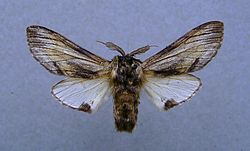| Tawny prominent | |
|---|---|
 | |
| Male | |
 | |
| Female | |
| Scientific classification | |
| Kingdom: | Animalia |
| Phylum: | Arthropoda |
| Class: | Insecta |
| Order: | Lepidoptera |
| Superfamily: | Noctuoidea |
| Family: | Notodontidae |
| Genus: | Harpyia |
| Species: | H. milhauseri |
| Binomial name | |
| Harpyia milhauseri (Fabricius, 1775) | |
| Synonyms | |
| |
Harpyia milhauseri, the tawny prominent, is a moth of the family Notodontidae. The species was first described by Johan Christian Fabricius in 1775. It is mainly found in central Europe. [1]

The wingspan is 50–60 mm. The moth flies from May to June depending on the location. [2]
The larvae feed on Quercus , Fagus and occasionally Betula .